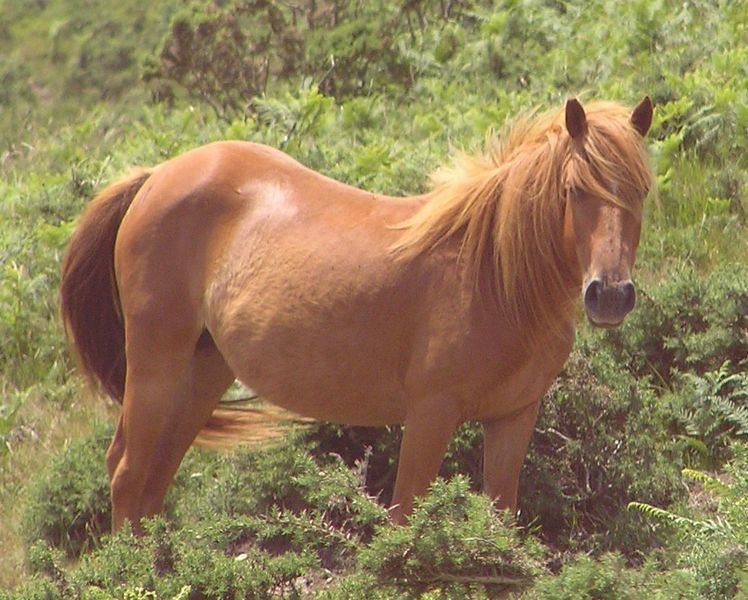Other names Red, sorrel Modifying genes | Variants Flaxen, Liver chestnut Body reddish-brown | |
 | ||
Base color Recessive extension "e" Description reddish-brown color uniform over entire body other than markings | ||
Chestnut is a hair coat color of horses consisting of a reddish-to-brown coat with a mane and tail the same or lighter in color than the coat. Genetically and visually, chestnut is characterized by the absolute absence of true black hairs. It is one of the most common horse coat colors, seen in almost every breed of horse.
Contents
Chestnut is a very common coat color but the wide range of shades can cause confusion. The lightest chestnuts may be mistaken for palominos, while the darkest shades can be so dark as to resemble a black coat. Chestnuts have dark brown eyes, black skin, and a coat that is entirely devoid of true black hairs. Typical chestnuts are some shade of red or reddish brown. The mane, tail, and legs may be lighter or darker than the body coat, but are never truly black. They may have pink skin beneath any white markings under the areas of white hair, and if such white markings include one or both eyes, the eyes may be blue.
Chestnut is produced by a recessive gene. Unlike many coat colors, chestnut can be true-breeding; that is, the mating between two chestnuts will produce chestnut offspring every time. Some breeds, such as the Budyonny, Suffolk Punch, and Haflinger are exclusively chestnut. Other breeds, such as the Belgian are predominantly chestnut. However, a chestnut horse need not have two chestnut parents. For example, Friesian horses have been selected for many years to be uniformly black, but on rare occasions chestnuts are born. The Ariegeois pony is another example.
Visual identification
Chestnuts can vary widely in shade and different terms are sometimes used to describe these shades, even though they are genetically indistinguishable. Collectively, these coat colors are usually called "red" by geneticists.
Chestnut family colors
Chestnut is considered a "base color" in the discussion of equine coat color genetics. Additional coat colors based on chestnut are often described in terms of their relationship to chestnut:
Combinations of multiple dilution genes do not always have consistent names. For example, "dunalinos" are chestnuts with both the dun gene and one copy of the cream gene.
Chestnut mimics
Inheritance and expression
The chestnut color, called "red" by geneticists, is created by an allele that is a mutation from the wildtype and is genetically the most recessive coat color that exists in modern horses. The gene for "red" color is designated as "e". This is because the presence or absence of red color in horses is determined by the equine melanocortin-1-receptor (MC1R), a protein positioned on chromosome 3 (ECA3) at the Extension locus. The wild type version of the gene encoding MC1R is the E allele (colloquially, though imprecisely, called the "Extension gene"), and is part of the genetic pathway that allows melanocytes to produce eumelanin, or black pigment. When the "E" allele is not present, no eumelanin is produced, but the "e" allele still allows melanin to be produced in the form of pheomelanin, or red pigment, creating a chestnut or red-based coat color. In general, alleles that create fully functional MC1R proteins are inherited dominantly and result in a black-based coat color ("E"), while mutated alleles that create "dysfunctional" MC1R are recessive and result in a lighter coat color ("e").
Red hair color in horses ("e") is created by a missense mutation in the code for MC1R, which results in a protein that cannot bind to the Melanocyte-stimulating hormone (MSH), which is released by the pituitary gland, and stimulates the production and release of melanin in skin and hair. So long as one functional copy ("E") is present, the protein is formed normally and black pigment is produced. However, when only mutant copies ("e) of the gene are available, non-functional MC1R proteins are produced. As a result, no black pigment is deposited into the hair and the entire coat is red-based. However, the skin of chestnut horses is still generally black, unless affected by other genes. Some chestnut foals are also born with lighter eyes and lightened skin, which darken not long after birth. This is not the same as the blue eyes and pink skin seen at birth in foals carrying the champagne gene. It is a genetic mechanism not fully understood, but may be related to the pheomelanistic characteristics of "e".
The recessive nature the chestnut or "red" coat in horses occurs because a single copy of the E allele is dominant over the e allele. Therefore, for example, bay and black horses may be heterozygous for e and if so, could produce a chestnut foal when bred to another horse with at least one copy of "e". However, all chestnut horses are homozygous for the "e" allele and thus breeding a chestnut to another chestnut will always produce a chestnut foal. Thus, unlike many coat colors, chestnut can be true-breeding; if any color other than chestnut occurs, then one of the parents was not chestnut.
Red can occur in horses that carry "E" when other genes influence its expression. In some cases, MC1R exists but is locally antagonized by the agouti signalling peptide (ASIP), or "agouti gene", which "suppresses" black color and allows some red pigment to be formed. This results in localized regions of black-rich or red-rich pigmentation, as seen in bay horses.
